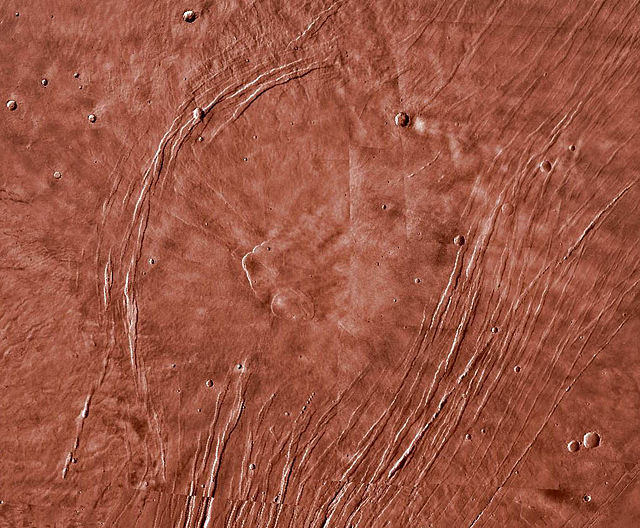Alba Mons is a volcano located in the northern Tharsis region of the planet Mars. It is the biggest volcano on Mars in terms of surface area, with volcanic flow fields that extend for at least 1,350 km (840 mi) from its summit. Although the volcano has a span comparable to that of the United States, it reaches an elevation of only 6.8 km (22,000 ft) at its highest point. This is about one-third the height of Olympus Mons, the tallest volcano on the planet. The flanks of Alba Mons have very gentle slopes. The average slope along the volcano's northern flank is 0.5°, which is over five times lower than the slopes on the other large Tharsis volcanoes. In broad profile, Alba Mons resembles a vast but barely raised welt on the planet's surface. It is a unique volcanic structure with no counterpart on Earth or elsewhere on Mars.

Viking image of Alba Mons. The volcano's relief is barely visible in orbital photographs. The broad system of fractures on the volcano's eastern side (right) is called Tantalus Fossae. The narrower fracture system on the western flank is Alba Fossae. (Viking color MDIM 2.1)
MOLA exaggerated relief view of Alba Mons central edifice and summit dome viewed from south (top) and north (bottom). Vertical exaggeration is 10x.
Central caldera complex of Alba Mons. The calderas are shallow compared to those on other Tharsis volcanoes. Within the larger caldera is a small shield capped by a concentric circular feature (near center). Image is about 200 km (120 mi) across (THEMIS daytime IR mosaic).
Dust mantle at the SW edge of small caldera on Alba Mons (HiRISE).
Tharsis is a vast volcanic plateau centered near the equator in the western hemisphere of Mars. The region is home to the largest volcanoes in the Solar System, including the three enormous shield volcanoes Arsia Mons, Pavonis Mons, and Ascraeus Mons, which are collectively known as the Tharsis Montes. The tallest volcano on the planet, Olympus Mons, is often associated with the Tharsis region but is actually located off the western edge of the plateau. The name Tharsis is the Greco-Latin transliteration of the biblical Tarshish, the land at the western extremity of the known world.
MOLA topography of the Thaumasia Plateau (Syria-Thaumasia block) and southern Tharsis. The volcano shown at the left is Arsia Mons. Valles Marineris extends across the northern edge. The areas in brown have the highest elevations on the Tharsis Plateau and may be considered the "summit region" of the Tharsis bulge.
Orographic water ice clouds hover over the volcanic peaks of the central Tharsis region in this color image mosaic from Mars Global Surveyor. Olympus Mons dominates at upper left. At center are the three Tharsis Montes: Arsia Mons at bottom, Pavonis Mons at center, and Ascraeus Mons at top.
Images of ice water clouds over Tharsis taken by the ExoMars Trace Gas Orbiter, 2016







